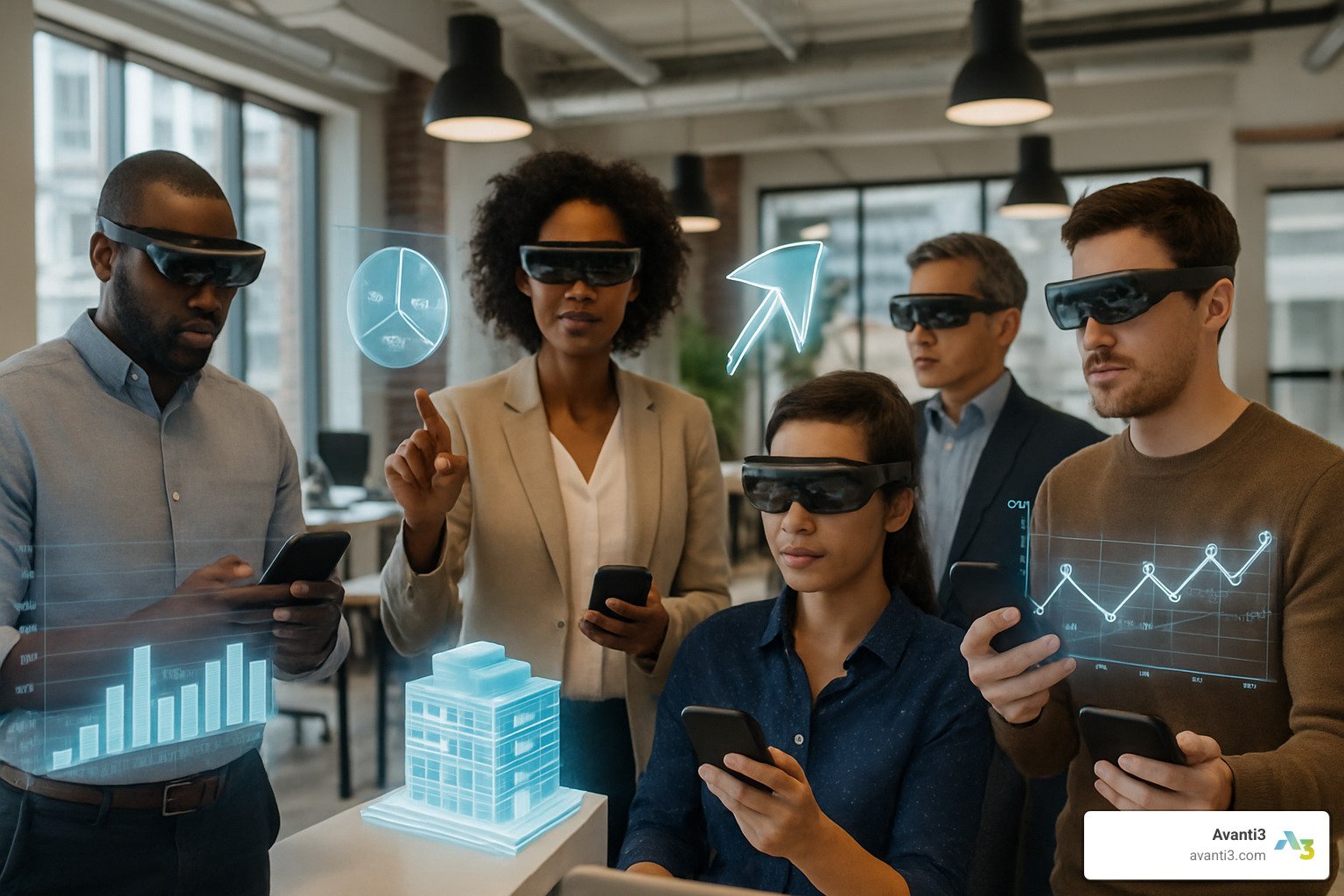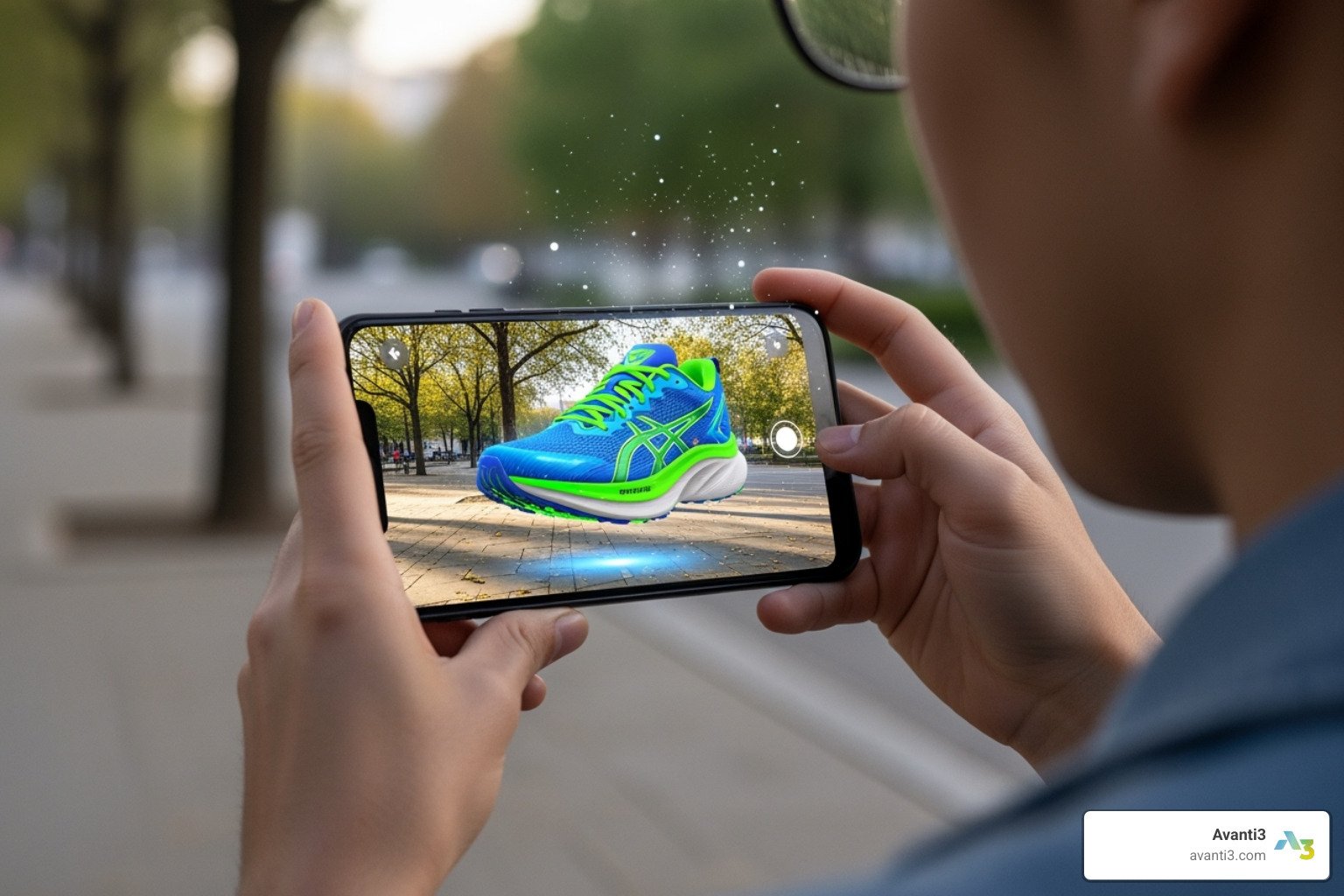Augmented Reality Solutions: Top 6 Powerful Benefits 2025
The Future is Here: Understanding Augmented Reality Solutions
Augmented reality solutions are interactive technologies that improve the real world with computer-generated perceptual information, creating immersive experiences by overlaying digital content onto physical environments. Unlike virtual reality which replaces reality, AR adds to it.
What are augmented reality solutions?
– Definition: Technologies that superimpose digital information onto the real world
– Types: Marker-based, markerless, location-based, and projection-based
– Hardware: Smartphones, tablets, smart glasses, and headsets
– Benefits: 95% increase in visual attention, 70% better memory encoding, 32% productivity improvement in manufacturing
Augmented reality sits on a spectrum between the physical world and fully virtual experiences. While VR immerses users in completely digital environments, AR enriches reality with contextual digital overlays that respond to real-world objects and spaces. These solutions have rapidly evolved from simple smartphone filters to sophisticated enterprise platforms powering everything from industrial maintenance to interactive retail experiences.
The business impact of AR is substantial and measurable. According to recent research, AR experiences capture 95% more visual attention than traditional media, improve memory encoding by 70%, and can increase productivity in manufacturing settings by an average of 32%. For brands, AR delivers a 74% boost in customer loyalty and impressive 94% lift in conversion rates through product visualization.
I’m Samir ElKamouny AV, an entrepreneur who has helped numerous businesses implement augmented reality solutions to transform their customer experiences and operational workflows. My experience with AR spans from retail visualization to industrial training applications, always focused on delivering measurable business outcomes.
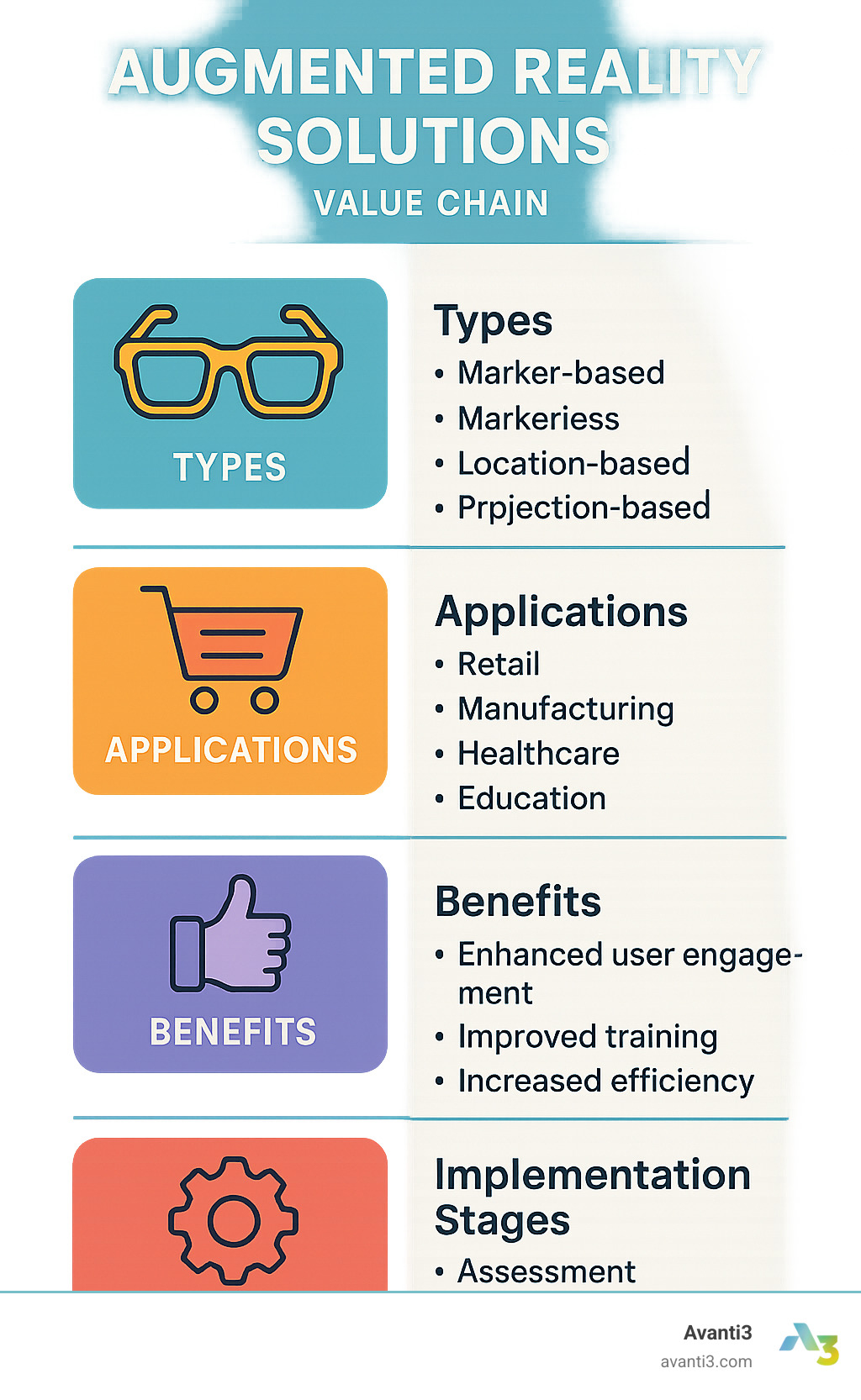
Why This Matters Now
The timing for augmented reality solutions couldn’t be more perfect. We’re experiencing a perfect storm of digital change that makes AR adoption not just viable but necessary:
- Mobile-first world: With over 6.8 billion smartphone users worldwide, the hardware for AR experiences is already in consumers’ pockets
- Digital natives dominate: Gen Z and younger millennials expect immersive, interactive experiences as standard
- Creator economy boom: Brands need new ways to engage audiences in increasingly crowded digital spaces
- Industry 4.0 acceleration: Manufacturing, healthcare, and retail are rapidly digitizing their operations and customer touchpoints
As part of the fourth industrial revolution, AR is bridging physical and digital worlds in ways that create tangible business value. The technology has matured beyond novelty to become a serious business tool driving measurable outcomes in engagement, efficiency, and revenue.
The 4 Main Types of Augmented Reality Solutions
When diving into augmented reality solutions, it’s helpful to understand that there’s not just one flavor of this technology. Each type has its own special powers and perfect use cases that can transform how businesses connect with customers and optimize operations.
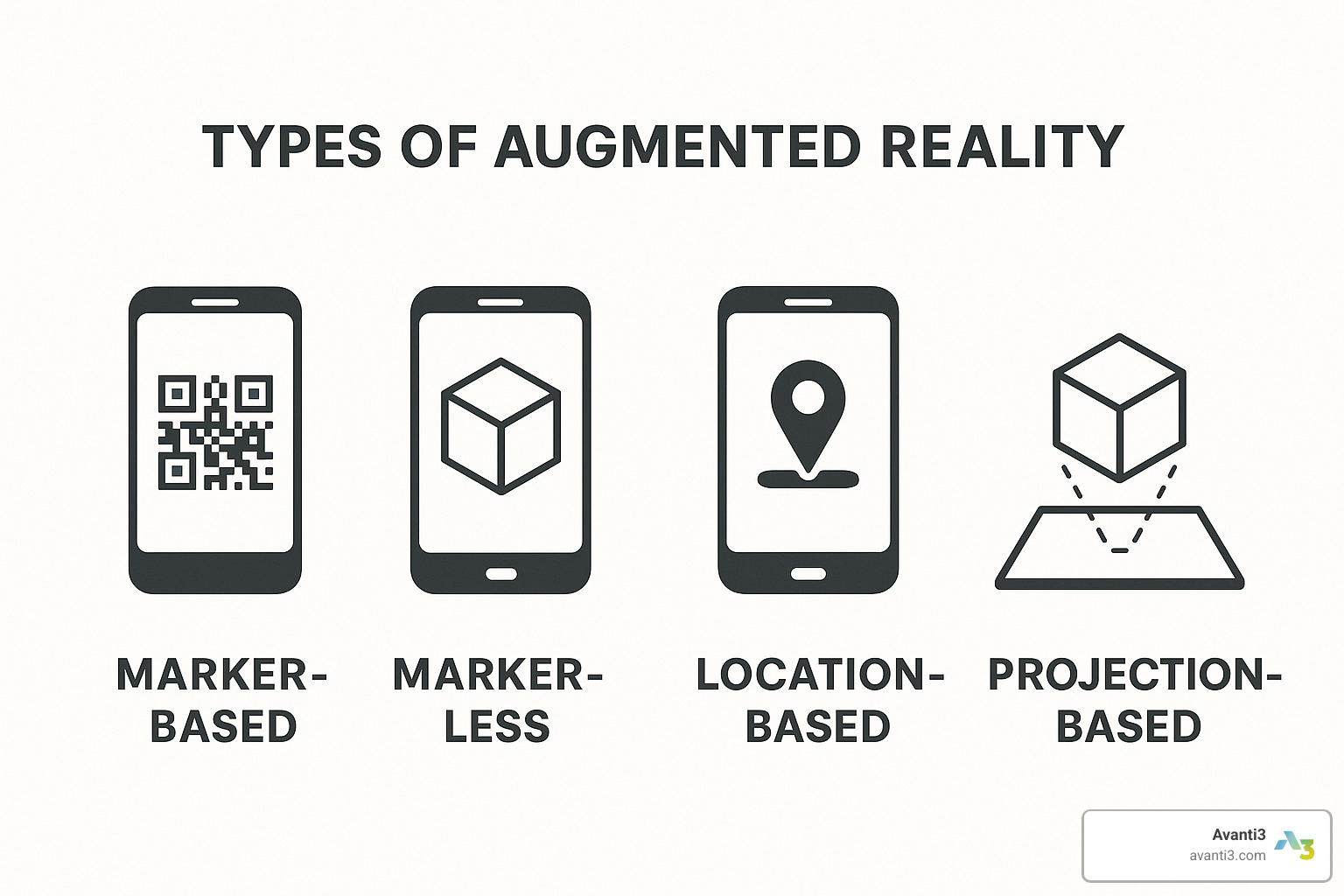
At their heart, all AR experiences rely on clever computer vision algorithms that process what your camera sees, understand the physical world around you, and then place digital goodies in just the right spots. But how they accomplish this magic varies quite a bit between the four main approaches.
Marker-Based Augmented Reality Solutions
Think of marker-based AR as the friendly neighborhood superhero of augmented reality – it’s been around longer, it’s reliable, and it’s easy to get along with. This approach works by recognizing specific visual cues (like patterns or images) that trigger digital content to appear.
Marker-based AR shines in its simplicity. When a customer points their phone at a special image on your product packaging, suddenly a character springs to life or an interactive experience begins. It’s like hiding a digital surprise inside everyday objects that only reveals itself to those “in the know.”
What makes marker-based AR special:
– It’s incredibly precise about where it places digital content
– It doesn’t demand super-powerful devices to work well
– It creates a clear “scan this to see something amazing” moment for users
– It’s budget-friendly for businesses just starting their AR journey
I’ve seen how marker-based AR transforms ordinary product packaging into memorable brand experiences. A simple QR code or product logo becomes the doorway to games, stories, or product demonstrations that customers love to share. For businesses looking to dip their toes into augmented reality solutions, this approach offers the perfect balance of wow-factor and practicality.
Want to explore how this could work for your brand? Check out our Augmented Reality Marketing page for inspiration and examples.
Markerless Augmented Reality Solutions
If marker-based AR is like following a treasure map, markerless AR is like having a sixth sense. This more advanced technology doesn’t need special images or codes – instead, it actively scans and understands the environment around you using SLAM (Simultaneous Localization and Mapping) technology.
Markerless AR is what powers those magical experiences where you can place virtual furniture in your living room before buying, or try on glasses without visiting a store. It recognizes floors, walls, and surfaces in real-time, creating a seamless blend between digital and physical.
The real game-changer has been WebAR – bringing markerless experiences directly to web browsers without requiring app downloads. This has opened the floodgates for brands to reach customers instantly. When shoppers can see products in their own space before buying, conversion rates jump by up to 94% – numbers that make any marketing team sit up straight!
Augmented reality solutions using markerless technology feel more natural and integrated into our daily lives. They understand the world around us rather than just looking for specific triggers, making the experience feel more like magic and less like technology.
Location-Based Augmented Reality Solutions
Location-based AR is like having a digital tour guide that knows exactly where you are and what you should see. By tapping into your device’s GPS, compass, and other sensors, these experiences deliver content based precisely on your physical location.
Remember the Pokémon GO phenomenon? That’s location-based AR in action – placing digital creatures in real-world locations that players could only find by physically going there. But the applications go far beyond gaming.
With the rollout of 5G networks improving location precision, businesses are finding creative ways to use this technology. Tourism companies overlay historical scenes onto modern landmarks. Warehouse workers receive turn-by-turn navigation to find products faster. Field technicians access location-specific maintenance instructions exactly when and where they need them.
For businesses with physical locations or those serving customers in specific places, location-based augmented reality solutions create powerful connections between digital experiences and real-world spaces. They transform “being there” into something extraordinary.
Projection & Superimposition AR Solutions
Now we’re entering the field of science fiction made real. Projection and superimposition AR bypass screens entirely, using projected light to display digital information directly onto physical objects and environments.
Imagine a factory worker assembling complex components with step-by-step instructions projected right onto their workbench. Or architects reviewing building designs with holographic models overlaid on physical scale models. These shared AR experiences can be visible to everyone in a room without requiring individual devices.
The impact on workplace performance is remarkable. Scientific research on worker performance shows that projection-based AR can slash error rates by up to 82% in complex assembly tasks. When instructions appear exactly where the work happens, people make fewer mistakes and finish faster.
While this type of augmented reality solution typically requires more specialized equipment, the efficiency gains make it a worthwhile investment for manufacturing, design, and industrial applications where precision and collaboration matter most.
Each of these four approaches to augmented reality opens different doors for businesses looking to create memorable experiences, streamline operations, or solve unique challenges. The question isn’t whether AR can help your business – it’s which flavor will deliver the most value for your specific needs.
Top 6 Industries Already Winning with AR
Augmented reality solutions aren’t just future tech anymore—they’re delivering real results right now across multiple sectors. Six industries in particular have acceptd AR with open arms and are seeing impressive returns on their investments:
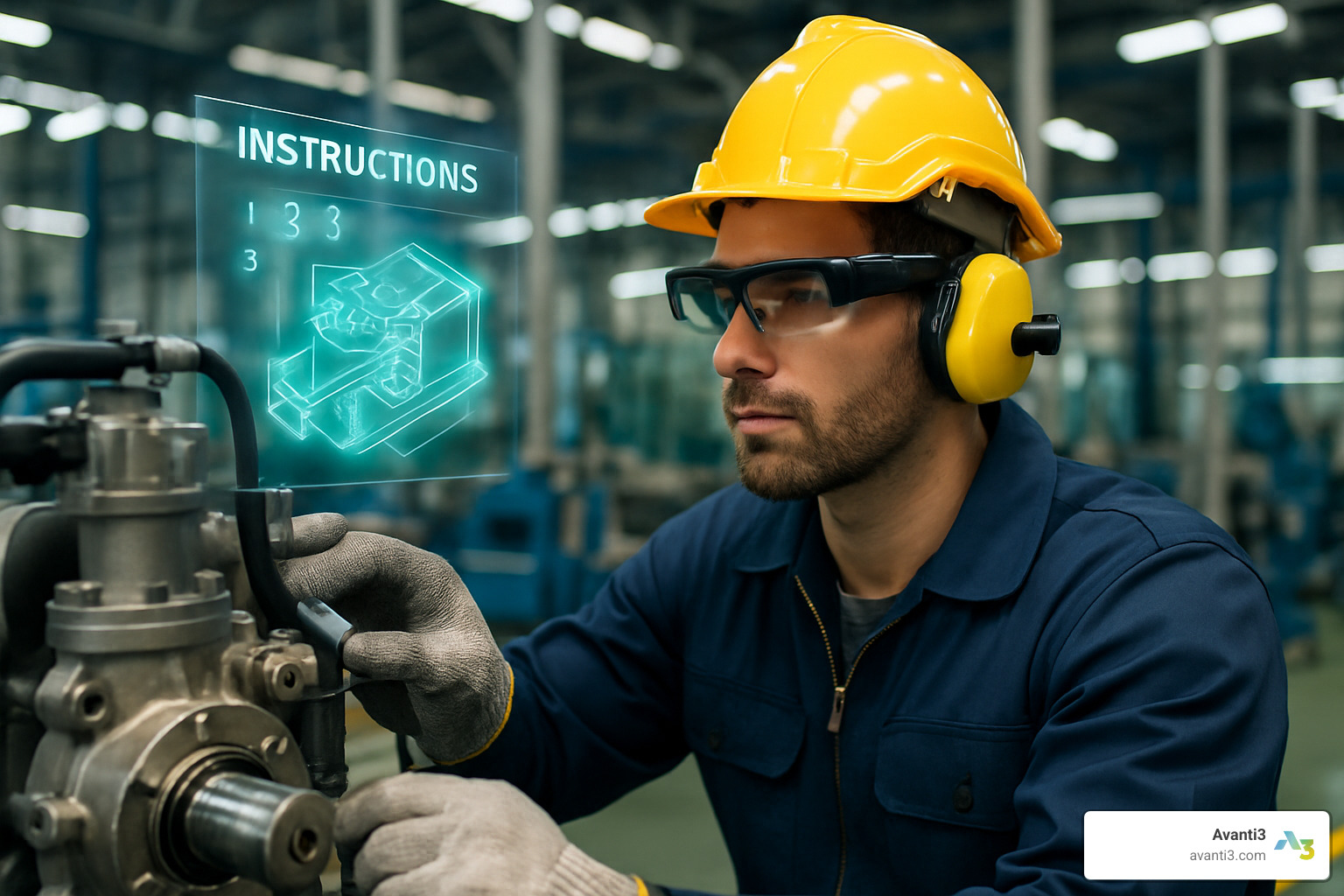
Manufacturing & Industrial
The factory floor has become AR’s proving ground, with manufacturers leading the charge in practical implementation. Assembly lines now feature workers using smart glasses that overlay step-by-step guidance directly onto workpieces, eliminating the need to consult manuals or computers.
Digital twins have revolutionized how teams visualize machine performance, allowing technicians to “see” inside equipment without disassembly. Quality inspection has been transformed with AR-guided verification points highlighting exactly what to check and how to check it.
The numbers tell the story: companies implementing augmented reality solutions in manufacturing environments report an average 32% boost in productivity. Boeing’s experience is particularly telling—they’ve cut wiring assembly time by a quarter while virtually eliminating errors. What makes AR so valuable in this setting is how it delivers exactly the right information at precisely the moment workers need it, especially in environments where consulting a manual would be impractical or dangerous.
Retail & E-Commerce
The age-old retail challenge of “try before you buy” has found its digital solution in AR. Virtual fitting rooms now let shoppers try on clothing, accessories, and makeup without changing a thing. Furniture retailers have acceptd AR to help customers visualize that new sofa in their actual living room before purchase.
In-store experiences have evolved too, with AR-powered navigation guiding shoppers directly to products while providing additional information with a simple scan. Loyalty programs have gained new life through gamified AR experiences that make earning points feel like playing a game.
The impact? An eye-popping 94% increase in conversion rates for products featuring AR visualization compared to those without. Perhaps even more valuable, retailers report that AR-engaged customers not only buy more but return products less frequently—a win-win for everyone involved. As retail continues blending digital and physical shopping journeys, augmented reality solutions are proving to be the perfect bridge between worlds.
Healthcare & MedTech
Few industries have more at stake than healthcare, where precision can literally be a matter of life and death. Surgeons are now using AR systems that overlay anatomical information directly on patients during procedures, improving accuracy and reducing risk. Nurses and phlebotomists benefit from vein visualization technology that makes IV placement less stressful for both provider and patient.
Medical education has been transformed by interactive 3D anatomical models that students can explore from every angle. Perhaps most exciting is how AR enables remote expert assistance—allowing specialists to guide colleagues through complex procedures from anywhere in the world.
The results speak for themselves: surgeons using AR guidance report up to 43% greater precision in certain procedures. By bridging expertise gaps and providing just-in-time visual information, augmented reality solutions are making healthcare safer and more effective every day.
Education & Training
Learning comes alive when students can see abstract concepts right in front of them. History classes now feature AR reconstructions that let students walk through ancient Rome or witness historical events firsthand. Science teachers use AR to show the inner workings of cells or the movements of our solar system at scale.
Corporate training has experienced perhaps the most dramatic change. Traditional training manuals and videos are giving way to guided AR experiences where employees practice skills with real-time feedback. The impact is remarkable—companies report up to 85% reduction in training time while simultaneously improving knowledge retention.
Research confirms what educators have observed: AR-improved learning improves memory encoding by up to 70% compared to traditional methods. By engaging multiple senses and providing spatial context for information, augmented reality solutions help knowledge stick in ways that reading or lectures simply can’t match.
Field Service & Utilities
When your job involves maintaining complex equipment across wide geographic areas, AR becomes less of a luxury and more of a necessity. Field technicians now wear AR glasses that display step-by-step repair instructions directly in their field of view, keeping both hands free for the actual work.
When they encounter problems beyond their expertise, technicians can connect with remote specialists who see exactly what they see and can guide them through solutions. Underground utilities and internal components of complex systems become visible through AR overlays, preventing costly and dangerous mistakes.
Companies implementing augmented reality solutions in field service report dramatic improvements—40% fewer repeat visits, 70% faster problem resolution, and significant reductions in errors. These efficiency gains translate directly to cost savings and happier customers who don’t have to wait as long for repairs.
Marketing, Events & Attractions
Marketers were among the first to recognize AR’s potential to capture attention in an increasingly distracted world. Product packaging now springs to life when viewed through a smartphone, telling brand stories or offering interactive games. Event spaces transform with AR activations that create shareable moments attendees can’t resist posting on social media.
Museums and attractions have acceptd AR to add layers of information and interactivity to exhibits. Concert venues use AR to improve performances with visual effects visible through fans’ phones. Promotional campaigns gain new life through gamified AR experiences that turn passive viewers into active participants.
The emotional impact of these experiences can’t be overstated—studies show AR marketing campaigns generate 55% stronger emotional responses and boost brand loyalty by 74%. At Avanti3, our AR Marketing Solutions help brands create these memorable moments that transform consumers from passive observers into active participants in your brand story.
The beauty of AR across all these industries isn’t just the technology itself—it’s how it solves real human problems in intuitive, almost magical ways. As the hardware becomes more accessible and the experiences more seamless, we’re just beginning to scratch the surface of what’s possible.
How AR Transforms Core Processes & Boosts KPIs
Beyond industry-specific applications, augmented reality solutions are changing fundamental business processes and driving impressive improvements across key performance indicators. These aren’t just incremental gains – they’re reshaping how work gets done.
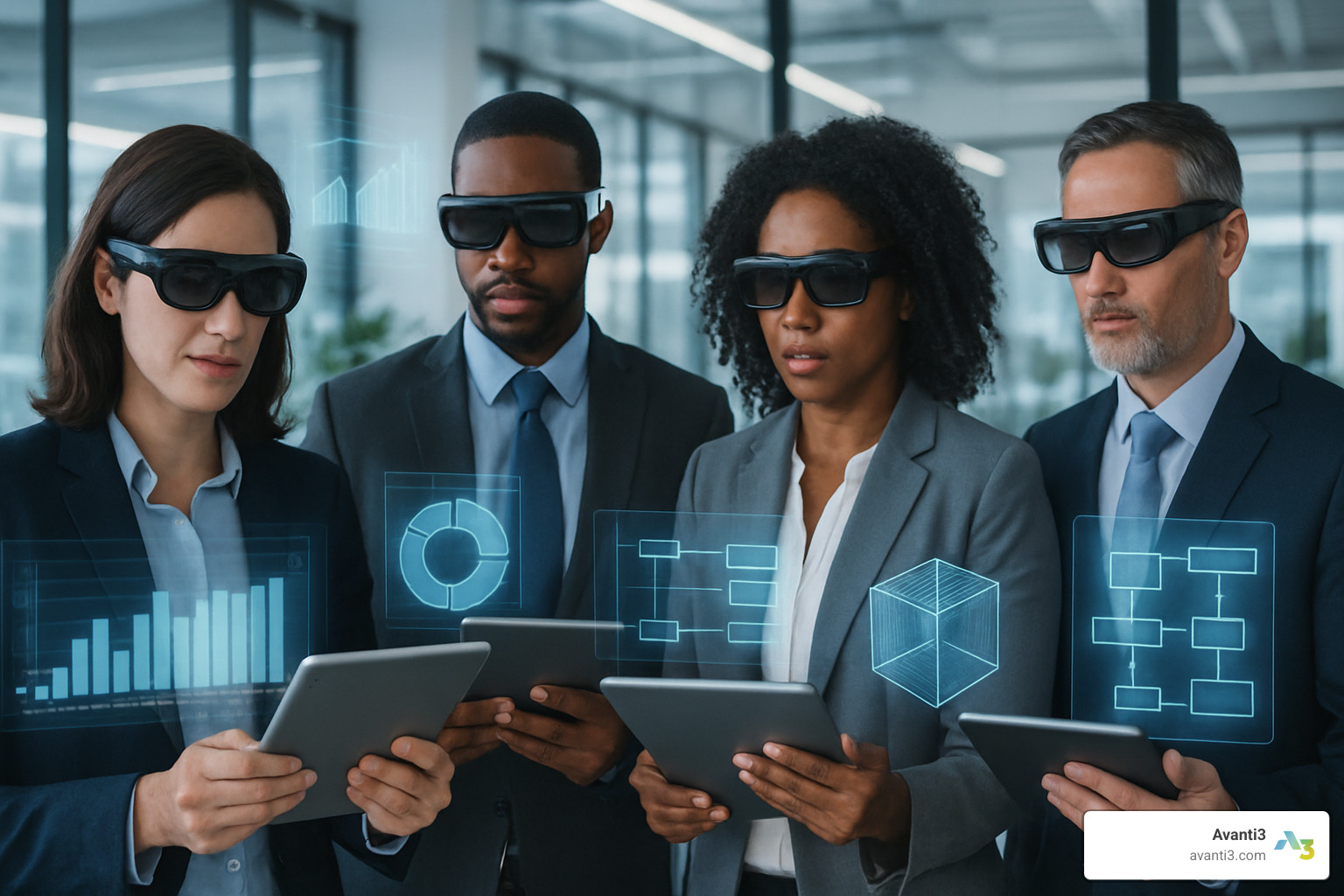
The numbers tell a compelling story. According to the latest research on smart manufacturing, companies integrating AR into their digital change strategies see faster adoption and better outcomes across multiple operational metrics. Let’s explore how AR is revolutionizing four core business functions.
Training & Onboarding
Remember your first day at a new job? That overwhelming feeling of information overload? AR is changing all that by making training experiential rather than theoretical.
Instead of reading manuals or watching videos, new employees can learn by doing in a guided, mistake-proof environment. They can see step-by-step instructions overlaid directly on equipment or workspaces, practice complex procedures without risk, and receive instant feedback on their performance.
The results are impressive – up to 85% reduction in training time compared to traditional methods. This acceleration happens because AR engages multiple learning pathways simultaneously, improving both comprehension and retention.
AR is also proving invaluable for capturing tacit knowledge from retiring workers – that hard-to-document expertise that typically walks out the door when experienced employees leave. With AR, this wisdom can be digitally preserved and shared with the next generation of workers, ensuring operational continuity and excellence.
Maintenance & Quality Control
“Trust but verify” takes on new meaning when augmented reality solutions enter the maintenance and quality control picture.
Imagine a technician approaching an unfamiliar piece of equipment. Rather than flipping through a manual, they see step-by-step visual overlays directly on the machine showing exactly which panel to open, which component to inspect, and how to perform the repair. Every step is verified digitally, creating an automatic audit trail.
This visual guidance reduces error rates by up to 82% while speeding completion times by 25-30%. The technology ensures consistent execution regardless of experience level – a novice can perform like an expert with the right AR support.
Quality control benefits similarly. AR-guided inspection ensures consistent standards across shifts and locations. When paired with AI detection, these systems can automatically identify defects or verify proper assembly, further reducing human error while accelerating processes. The days of clipboard checklists and paper sign-offs are giving way to digital workflows that are faster, more accurate, and fully documented.
Sales & Customer Experience
We’ve all hesitated before buying something online. “Will it actually look good in my home?” “Is this the right size?” “Does this feature really work the way I think it does?” AR eliminates these barriers by letting customers see and interact with products before buying.
The emotional impact is significant – AR experiences generate a 55% increase in emotional response compared to traditional marketing approaches. When customers can virtually place furniture in their living room, try on glasses without visiting a store, or see how a new appliance would fit in their kitchen, purchase anxiety disappears.
This confidence translates directly to business outcomes, with AR product visualization driving up to 94% higher conversion rates. Perhaps even more valuable is the 74% improvement in brand loyalty among AR users. By creating memorable, emotionally engaging experiences, AR strengthens customer relationships beyond the initial purchase, contributing to higher lifetime value and turning customers into brand advocates.
Data-Driven Insights
Here’s something many businesses overlook: AR isn’t just changing how we work and shop – it’s also generating valuable data that can inform product development, marketing, and operational decisions.
Every interaction in an AR experience can be tracked and analyzed. Which features do users focus on first? How long do they spend examining different aspects of a product? What information do they find most valuable? This creates detailed heatmaps of user attention and interaction patterns that were previously impossible to capture.
This spatial interaction data helps organizations understand not just what customers do, but how they physically engage with products and information. These insights drive improvements in everything from product design and store layouts to marketing messages and training materials.
The best part? This creates a continuous improvement cycle based on actual user behavior rather than surveys or guesswork. When combined with A/B testing capabilities – showing different users different AR experiences – companies can rapidly iterate and optimize their offerings based on real-world data.
In each of these areas, augmented reality solutions aren’t just making existing processes better – they’re fundamentally changing how work gets done, creating new possibilities for efficiency, engagement, and insight that weren’t possible before.
Roadmap: Developing & Integrating Your First AR Solution
Starting on your augmented reality solutions journey doesn’t have to be overwhelming. Think of it as building a bridge between your current business processes and an exciting new dimension of possibilities. Let me walk you through how to make this happen with confidence and clarity:
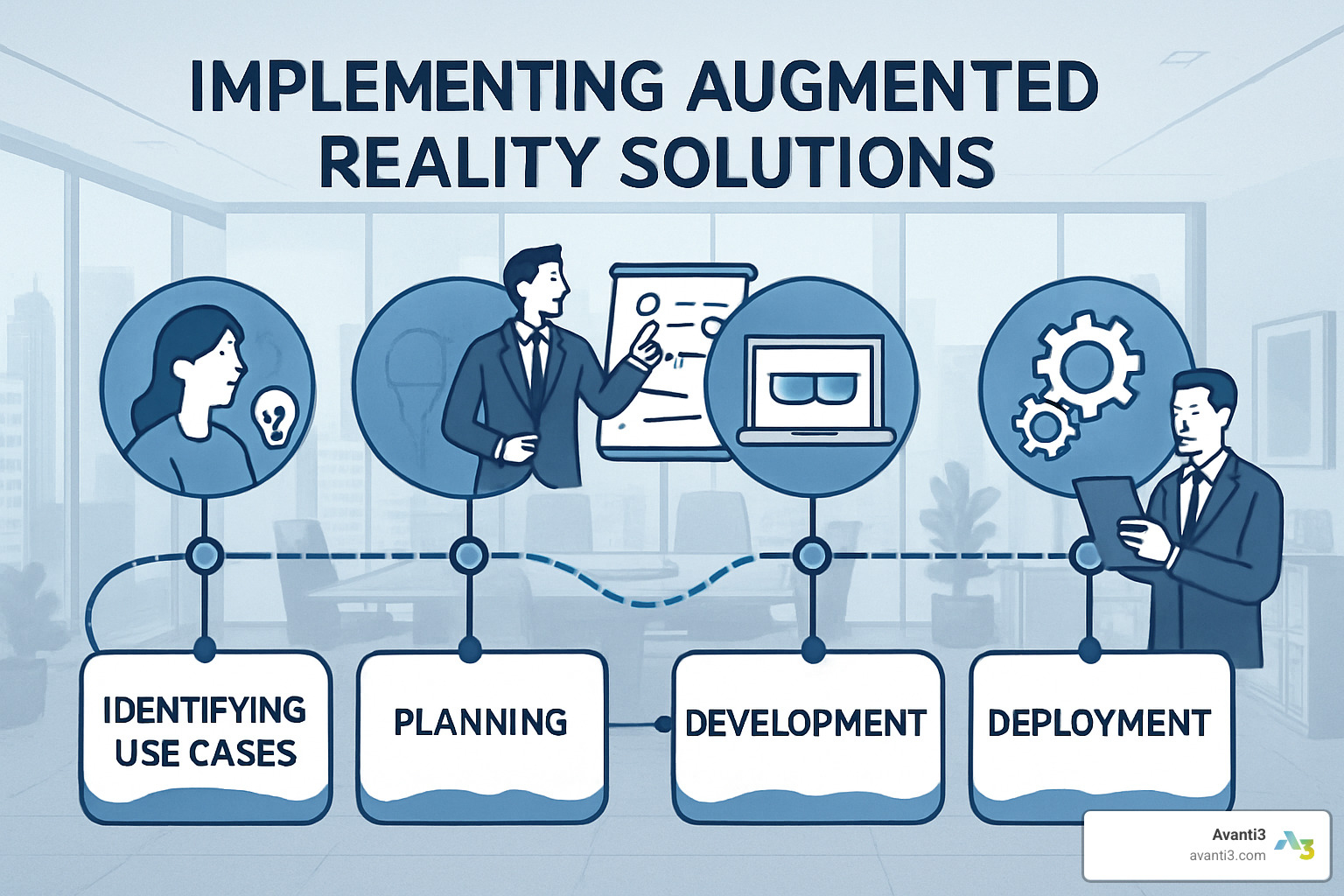
Step-by-Step Checklist
Starting your AR journey is a bit like cooking a great meal – you need the right ingredients and a clear recipe before you begin. First, identify a specific pain point your business needs to solve. The best AR implementations don’t try to boil the ocean; they focus on concrete problems where visual guidance can make a real difference.
Once you’ve pinpointed your use case, it’s time to choose your technology platform. This decision resembles picking the right tool for a job – ARKit for iOS devices, ARCore for Android, or perhaps a cross-platform solution like Vuforia might be your best fit. If you want to reach the widest audience without requiring app downloads, WebAR could be your perfect match.
Next comes what I like to call the “digital ingredients” phase – establishing your 3D asset pipeline. Whether you’re converting existing CAD files, capturing real objects through photogrammetry, or working with 3D artists to create models from scratch, you’ll need a consistent process for creating, optimizing, and managing these assets. Think about this as building your digital inventory – one that needs to be properly labeled, stored, and ready for use.
With your foundation in place, it’s time to develop a prototype that brings your vision to life. This doesn’t need to be perfect – in fact, it shouldn’t be! The goal is to create something tangible that users can interact with and provide feedback on. I’ve seen companies transform their entire approach based on these early testing sessions, saving countless hours and resources by identifying issues early.
The magic really happens when you iterate based on insights from real users. Maybe your assembly instructions need more visual cues, or perhaps users struggle to trigger certain features. Each round of feedback helps you refine both the experience and the underlying technology, bringing you closer to a solution that truly delivers value.
As your solution matures, you’ll need to plan for deployment and support. This includes preparing training materials, setting up help resources, and establishing processes for updates and maintenance. Even the most brilliant AR solution won’t deliver results if people don’t know how to use it effectively.
Finally, once you’ve proven success with your initial implementation, you can scale to additional use cases or locations. This is where the real organizational change begins, as AR becomes integrated with your core business systems and processes.
At Avanti3, our AR/VR Immersive Experiences team works alongside clients through each of these steps, turning technology possibilities into business realities.
Measuring ROI & Success
“If you can’t measure it, you can’t improve it” – this old business adage rings especially true for augmented reality solutions. The good news is that AR implementations generate wonderfully concrete data points that tell a compelling ROI story.
For operational teams, the metrics that matter most often relate to efficiency and quality. How much faster can workers complete tasks with AR guidance? We’ve seen manufacturing clients cut assembly times by 25-30% while dramatically reducing errors. Training managers love to measure how quickly new employees reach competency – with AR-based training often cutting onboarding time by up to 85%.
On the customer-facing side, marketing and sales teams should watch for improvements in conversion rates (often jumping 40-90% with product visualization), increases in average order value, and reductions in return rates. The emotional connection created through AR experiences also drives measurable improvements in brand loyalty and customer satisfaction scores.
The key to meaningful measurement is establishing your baseline before implementation. Take the time to document current performance metrics so you can clearly demonstrate improvements after AR deployment. This before-and-after comparison creates compelling evidence that can justify expanded investments and implementations.
Overcoming Challenges
Let’s be honest – implementing new technology is never without problems. The good news is that with a bit of foresight, you can steer the common challenges of augmented reality solutions with confidence.
Hardware considerations often top the list of concerns. While consumer smartphones have democratized access to AR, specialized headsets still carry significant costs. Start by leveraging devices your team or customers already own, then scale to more specialized hardware as your program proves its value. Be thoughtful about environmental factors too – bright sunlight can make outdoor AR difficult, while crowded factory floors might limit movement.
User adoption requires just as much attention as the technology itself. Even the most brilliant AR solution fails if people don’t use it. I’ve found that involving end-users early in the design process, creating intuitive experiences that solve real problems, and providing adequate training all dramatically improve adoption rates. People aren’t resistant to new technology – they’re resistant to disruption without clear benefits.
On the technical side, integration with existing systems often presents the biggest challenge. Your AR solution likely needs to pull data from inventory systems, product databases, or training materials. Planning these connections early and working with experienced integration partners can prevent headaches down the road. Data security deserves special attention, particularly for applications involving sensitive product information or customer data.
Finally, don’t underestimate organizational factors like the skills gap for AR development and management. Building internal expertise through training while partnering with experienced providers like Avanti3 creates the right balance of self-sufficiency and specialized support.
The most successful AR implementations I’ve seen share a common approach – they start small with focused pilot projects, learn and adapt based on real-world use, and scale methodically as they demonstrate value. This measured approach allows you to build both technical capabilities and organizational support simultaneously.
FAQs & Final Thoughts

The journey of augmented reality solutions has been remarkable – evolving from a futuristic concept to an accessible, powerful business tool. What was once considered cutting-edge technology is now delivering measurable impacts across operations, customer experiences, and financial outcomes for organizations of all sizes.
Do augmented reality solutions work on regular smartphones?
Good news! Your everyday smartphone is already AR-capable. Most modern iOS and Android devices support rich augmented reality experiences through Apple’s ARKit and Google’s ARCore frameworks. These powerful platforms enable your phone to detect surfaces, track objects, and render realistic digital content right on your screen.
Even better, the rise of WebAR has made experiences even more accessible. Now users can simply visit a website to launch an AR experience – no app download required. This approach not only makes life easier for your customers but also significantly reduces your development costs.
While dedicated AR headsets certainly offer more immersive, hands-free experiences (and they’re getting better every year), smartphone-based AR provides an excellent starting point with virtually no hardware investment. Your customers already have powerful AR devices in their pockets!
How secure is my data in an AR deployment?
Security is understandably a top concern when implementing new technology, and AR is no exception. The good news is that enterprise-grade AR platforms have matured to offer robust security features to protect your sensitive information.
Enterprise solutions typically include end-to-end encryption for all data transmission and SOC 2 compliance for cloud services. If you’re operating in regions with strict privacy regulations, look for GDPR-compliant data handling and storage practices.
For industries dealing with highly proprietary information – like manufacturing or healthcare – many vendors offer on-premises deployment options that keep your visual data and intellectual property within your own secure network.
When evaluating AR platforms, pay particular attention to how visual data is processed, what information travels to the cloud, and how user permissions are managed. Your AR partner should be able to clearly explain their security architecture and compliance standards in a way that aligns with your specific requirements.
What budget should a mid-size firm expect?
Let’s talk money – always the practical question! The truth is that AR implementation costs vary widely based on your specific needs and approach.
For smaller initiatives or initial explorations, you might consider WebAR marketing campaigns starting around $5,000-$25,000 or simple AR visualization apps in the $15,000-$50,000 range. Many off-the-shelf AR training modules are available for $500-$5,000 monthly, offering a low-risk entry point.
Mid-range implementations typically include custom AR applications custom to specific use cases ($50,000-$150,000) or integrated solutions that connect with your existing systems ($75,000-$200,000). Content management platforms generally run $2,000-$10,000 monthly depending on your scale.
For comprehensive enterprise deployments, company-wide AR platforms often start around $200,000, with custom hardware and software ecosystems potentially reaching $500,000 or more. Ongoing content and platform management might require $10,000+ monthly.
The smartest approach? Start with a focused pilot project to demonstrate value before making larger investments. This strategy lets you validate ROI and refine your approach with minimal risk. Many of our clients at Avanti3 have found that subscription-based AR platforms significantly reduce upfront costs while allowing for gradual scaling as value is proven.
Looking to build deeper community engagement through immersive experiences? Explore our community building platforms that integrate AR with other engagement technologies for a comprehensive approach.
As we look to the future, augmented reality solutions will continue to transform how we work, learn, shop, and connect. The technology is becoming more intuitive, more powerful, and more accessible every day. Whether you’re just beginning to explore AR’s potential or ready to scale existing initiatives, there’s never been a better time to improve your real world with digital innovation.
At Avanti3, we’re passionate about helping organizations harness the power of next-generation digital experiences through our one-stop engagement platform. Let’s create something amazing together!
The Future of Augmented Reality Solutions
The future of augmented reality solutions is incredibly bright, with several trends ready to accelerate adoption and impact:
- Hardware evolution – Lighter, more powerful AR glasses and headsets will make all-day wear practical for industrial applications
- AI integration – Artificial intelligence will improve AR with real-time object recognition, predictive maintenance alerts, and personalized guidance
- 5G connectivity – Ultra-low latency networks will enable more sophisticated real-time AR experiences and remote collaboration
- Spatial computing – AR will increasingly become part of broader spatial computing ecosystems that blend physical and digital environments
- Democratized creation – No-code and low-code tools will make AR content creation accessible to non-technical users
At Avanti3, we’re at the forefront of these trends, integrating Web3 technologies like NFTs and blockchain with AR/VR and AI to create next-generation digital experiences. Our platform empowers creators and brands with customizable engagement tools and fintech solutions that transform how they connect with audiences and monetize digital interactions.
By providing unique digital experiences, rewards systems, and community-building opportunities through our community platforms, we’re setting new standards in digital engagement and fan monetization.
The question for organizations is no longer whether to adopt augmented reality, but how quickly they can implement it to gain competitive advantage. Those who move decisively to integrate AR into their operations and customer experiences will find themselves well-positioned for success in an increasingly digital future.
Are you ready to explore how augmented reality solutions can transform your business? We’d love to help you identify the right opportunities and develop a strategy for successful implementation.

